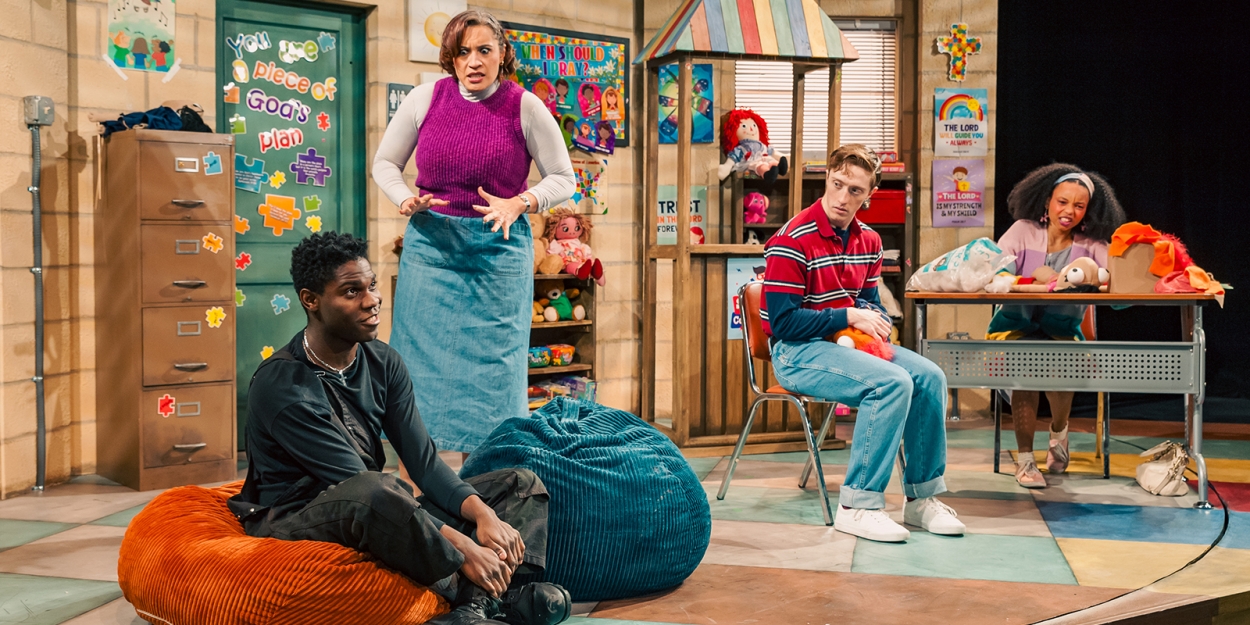Review: HAND TO GOD at Keegan Theatre
Do not miss this subversive, hilarious and enlightening excursion into the maelstrom of the human mind.

The audacious and lively play Hand to God is a daring and yet, an oddly compelling and textured meditation, on society’s hypocrisies set within a more intimate framework of five characters whose minds are tortured with clashes between reason and fiery lust -driven passions. This play makes the puppet -driven 2004 musical Avenue Q look like Mary Poppins by comparison; this play is much more acidic and radically subversive in tone.
Director Josh Sticklin creatively portrays the day-to-day texture of the small town of Cypress, Texas where a church’s puppet show predominates. This puppet show is only one level of this show; the human characters are also satirized with cutting -edge parody, doses of disarming sweetness and sober-faced line readings which are delivered--by a superb group of actors who portray the five characters –in order that the ironies and comedy of this unique play can naturally unfold and catch the audience unaware at crucial moments.
Playwright Robert Askins pushes the envelope to excess to actually unspool basic human truths that lie underneath the noise and sensational effects. There is a decided “method to the madness” in this cult (NOT a religious cult intended) play that goes to deliberate extremes to uncover the fight between the characters’ conscience and their passionate drives. The human battles to control inner battles of their internal demons versus their “better angels” (the id versus the superego) is played out via puppetry --as the human’s conflicted inner psyches are soothed or diminished by their puppet appendages.
Like other cult theatre favorites such as The Rocky Horror Picture Show and Little Shop of Horrors, this play is a quirky delight for very specialized tastes. Though it satirizes themes of religion, church, and family it does so in order to show how the nuances of the shrill hypocrisies of religious and decadent/satanistic extremes can infect individual’s minds. The texture of this play has the tone and the infectious yet quirky delivery of such cult television favorites as Mary Hartman, Mary Hartman, Sordid Lives, Pee-Wee’s Playhouse, and Schitt’s Creek.
Theatrical skits such as the “Who’s on First” classic sketch, frenetic physical fights, and lust-driven passions (bravos to fight and intimacy director Sierra Young) are hilariously evoked and there is another layer in the play----a display of many theatrical entertainment styles.
The puppet design by Luke Hartwood is “jaw-dropping” in its life-like and very animated design. Actor Drew Sharpe’s character of Jason is hysterically funny---and often subtly moving---as he manipulates his “puppet’ named Tyrone (Mr. Sharpe’s control of his puppet is masterful—and his vocal flexibility with two differing voices is faultless). His puppet (that is used in school plays) is no longer his to control as the puppet begins to control every good thing that Jason attempts to do; in the second act the tables are turned, and the devil takes control of the puppet Tyrone.
Shadia Hafiz’ portrayal of Margery is superb as she plays the repressed mother and mentor. Ms. Hafiiz’ Texas twang is delivered with a very charming inflection and flavor.
Dominique Gray as Pastor Greg plays his part with natural ease and calm bewilderment. Mr. Gray intriguingly plays his part subtly without shouting or yelling when his character is upset and, consequently, he makes his part that much more effective.
Jordan Brown as the rebellious student Timmy is especially good at delivering sarcastic retorts with zesty and confident comic timing and he possesses a fine skill at physical comedy.
Hannah Taylor as Jessica is very natural and unassuming in her role –and, thus, she is a good non-reactive foil for interaction with the more explosive characters. Ms. Taylor’s puppetry skills with her puppet “Jolene” are exemplary.
Very graphic scenes are played with just the right comic timing and pacing especially the scenes between Margery (Shadia Hafiz) and Timmy (Jordan Brown).
All technical credits are above par –especially the scenic design by Mattheew J. Keenan. A rotating set compels the eye as differing sections rotate in full view to dictate the successive scenes. A church rectory office, a bedroom, a playground with a swing set, and –most impressively-, a church basement/social-recreation hall are all shown to significant effect. This church basement is very colorful and eye-catching with posters of Jesus’ love proclaimed on the walls, a file cabinet, tables, a puppet theatre, and a table for making puppets and crafts. (As the second act opens—there is a major change in the scenic effect from the spiritual to the satanic).
Sound design by Brandon Cook includes many ear-catching songs that keep the auditory ambience alive ---the Art Reynolds’ song “Jesus is Just Alright” (made famous by the Doobie Brother amidst other groups) particularly stand out.
Costume design by Logan Benson is colorful and vibrant.
Lighting design by Sage Green is efficient and sharply evoked.
Hand to God draws to a very tightly coiled ending as the character of Jason tires to chop off his hand (which is increasingly growing demonic puppet) but this is not as fraught an ending as I thought---for Jason is finally making the choice to choose the good as he offers his “hand to God.”
The Keegan Theatre should be commended for producing such a provocative play in these challenging times. Do not miss this subversive, hilarious and enlightening excursion into the maelstrom of the human mind.
Running Time: One hour and forty-five minutes with one 15-minute intermission.
Hand to God runs through March 2, 2025, at the Keegan Theatre located at 1742 Church Street, NW, Washington, DC, 20036.
Photo credit: L-R Jordan Brown, Shadia A. Hafiz, Drew Sharpe, and Hannah Taylor in Keegan Theatre's production of Hand to God. Photo by Mike Kozemchak.
Reader Reviews

Videos

